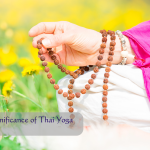Millions of people throughout the world suffer from back discomfort. It may seriously affect daily routines and lower your quality of life. While traditional treatments like medicine and physical therapy might provide comfort, many people prefer alternative approaches. One such alternative is Thai Yoga Massage, which has developed as an effective treatment option. By combining yoga, acupressure, and stretching, it helps relieve back pain and increase overall well-being.
This traditional medicinal therapy, which originated in Thailand, aims to improve energy flow (known as “sen lines”) throughout the body. Specifically, Thai Yoga Massage works by delivering gentle yet strong pressure, rolling actions, and supported yoga poses to tight muscles. Consequently, it enhances flexibility and relieves pain.
This blog explores the world of Thai Yoga Massage for Pain Relief. In the following sections, we’ll look at the effective methods employed by professionals, the possible benefits of this new therapy, and what to expect during a session. Additionally, we’ll provide you with ideas on how to get the most out of Thai Yoga Massage while also having a safe and fun experience.
Understanding Back Pain
Back pain can arise from various factors, including:
- Muscle strain or tension: Poor posture, and moving heavy objects can cause muscular strain and tightness in the back, resulting in pain.
- Spinal disc problems: Degeneration or herniation of discs between vertebrae can irritate nerves and cause pain or weakness.
- Arthritis: Wear and tear on the joints in the spine can cause inflammation and pain.
- Sciatica: Compression of the sciatic nerve, which runs from the lower back through the legs, can cause radiating pain down the leg.
Effective Techniques for Back Pain Relief
Thai Yoga Massage uses a variety of techniques to relieve back pain and promote healing. Let’s take a closer look at several crucial methods:
- Assisted Stretching: The therapist gently takes you through several yoga poses, with a focus on stretches that loosen up the hips, thighs, and lower back. This improves flexibility and relieves tension in the muscles that cause discomfort.
- Acupressure: Thai massage practitioners, like those in traditional Chinese medicine, apply pressure to precise places along the body’s energy lines. These points are thought to correspond to specific organs and systems in the body. Thai massage uses these spots to promote energy flow and relieve pain.
- Palm and thumb presses: The therapist applies deep, rhythmic pressure to particular regions of the back with their palms, thumbs, elbows, and, in some cases, feet. This relieves muscle tension, improves circulation, and reduces discomfort.
- Rocking and Moving Movements: The therapist will gently rock and swing your body in various directions. These movements can assist in relieving tight muscles and joints in the back, resulting in relaxation and pain reduction.
- Herbal Compresses (Optional): Some Thai massage sessions may include herbal compresses infused with medicinal herbs and heated to relieve heat. These compresses are used on certain areas of the back to improve blood circulation, reduce inflammation, and reduce discomfort.
Benefits of Thai Yoga Massage for Back Pain
Research suggests that Thai Yoga Massage can offer a range of benefits for pain sufferers, including:
- Pain Relief: Thai massage has been demonstrated in studies to be beneficial in reducing pain intensity and improving function in people with chronic back pain.
- Improved Flexibility: Thai massage’s stretching techniques help to lengthen and release tight muscles, resulting in greater back flexibility and range of motion.
- Stress Reduction: Stress might worsen pain. Thai massage’s emphasis on relaxation and increased energy flow might assist reduce general tension, which may indirectly aid with pain management.
- Enhanced Circulation: Using pressure and movement during a Thai massage session helps enhance blood circulation in the back, facilitating healing and relieving muscle tension.
- Increased Range of Motion: Improved flexibility in the back muscles and joints can lead to a greater range of motion, allowing for easier movement and reduced pain.
What to Expect During a Thai Yoga Massage Session
A normal Thai Yoga Massage session lasts 60-90 minutes. To begin with, you’ll dress loosely and comfortably so that you may move freely. During the session, the massage is performed on a mat on the floor. Moreover, the therapist will use their hands, elbows, knees, and feet to push your body into various stretches.



